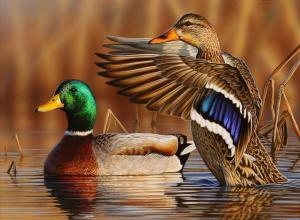Clifton returns to Clifton, wins second federal stamp contest
Wildlife artist Richard Clifton lives on the edge of Prime Hook National Wildlife Refuge. The plants, birds and animals of the marsh are part of his everyday existence.
As hunter and birdwatcher for decades, Clifton has honed his observation skills. That has played no small part in his ability to not only make a living, but to also build an international reputation for his waterfowl art.
In September this year, judges for the annual federal duck stamp competition notified Clifton that his acrylic entry of a lesser scaup - also known as a bluebill or blackhead - will grace the stamps for the 2021-2022 hunting season.
All waterfowl hunters are required to purchase a federal duck stamp and a state duck stamp as part of their annual licensing requirement. The millions of dollars generated by sales of those stamps to hunters, birdwatchers and other outdoors conservation-minded people benefit waterfowl habitat preservation and maintenance.
A Delaware win too
Earlier this year, Delaware announced that Clifton’s depiction of a pair of mallards won the state duck stamp competition for the 2021 season. Winning the federal contest for his second time in 14 years elevated that success to a new level.
Clifton began his effort to win this year’s federal competition last March. Getting up in the predawn hours to hunt for ducks is familiar territory for hunters. But in this case Clifton had to get up even earlier to drive across the Delmarva Peninsula not to hunt, but to photograph diving ducks like the lesser scaup with their full spring mating plumage illuminated by the day’s first light.
“I spend a lot of time getting reference material before I start building a painting. In this case a photographer friend of mine told me about a place on the Choptank River, right in Cambridge, where people have been feeding diving ducks for decades. It’s been imprinted in them now and they come back every year. In the photo world, people come from all over the country to see these ducks.”
Clifton’s entry for this year’s competition had to not only capture the colorful feathers of the scaup, but it also had to include an additional and controversial element. “A couple years ago contest officials thought it would be a good idea to require a nod to the nation’s hunting heritage in the entries Nobody liked it, nobody wanted it and a majority of the comments when the idea was suggested were against it. But they did it anyway.
“Conservationists, birdwatchers and other non hunters were coming around to be more supportive of duck stamps. This angered some of them. But it is what it is. Personally I’m a birdwatcher and a hunter so it didn’t bother me, but I’d rather they remove that requirement. It’s hard enough to build a knock-out painting that will translate well in the small stamp format. The hunting heritage mandate just further complicates it.”
To meet this year’s requirement, Clifton added a lanyard with two calls floating in the water next to a swimming scaup. “I showed the lanyard draped over a group of broken cattails as if it had been lost by a hunter. There was a certain amount of artistic license but I actually did find one of the calls - an Olt Mark 5 duck call - floating in the creek down from my house. I thought the lost calls were a clever touch.” Apparently the judges didn’t disagree.
After Clifton won the big federal competition in 2006, he wasn’t allowed to enter again for three years.
“After that I tried hard to win again. I started overthinking - trying too hard for the federal prize. I got away from the kind of painting Richard Clifton would paint. No success. But last year I went back to my traditional style with a single black duck drake. It felt good. Felt like I went back and painted a Richard Clifton. I and a lot of others thought it had a shot at winning, but it didn’t.”
As soon as Clifton heard he hadn’t won last year, he immediately started thinking about this year’s entry. “I didn’t think I could paint any better than that. but I found out I could with the scaup that won this year. The duck prominent in the foreground with the background brushed out. I found out I just have to be me. Paint like I paint. You can’t be afraid to lose. In the end, It felt really good to win again.”
I asked Richard what could feel better for a waterfowl artist that to win the prestigious federal duck stamp contest two times. He answered quickly.
“Maybe a third time. The only thing better would be to win a third time.”


























































